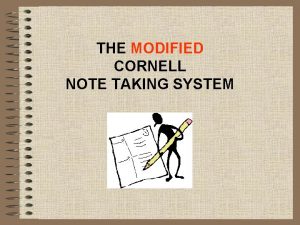Cornell Notes Notetaking strategy that will improve your













- Slides: 13

Cornell Notes Note-taking strategy that will improve your study skills and your grades!!

Problems with taking notes • I can’t write everything down the teacher says because he/she talks TOO fast! • I can’t read my notes. • The notes I take when I read don’t help.

Don’t be like this guy…

…. or her

What’s the advantage of Cornell notes? • Helps me take organized notes. • Helps me identify key words and concepts from lecture or reading. • Improved grades.

Set up your paper Address your paper like you normally would any other paper. -Include name, date, and class period. Now use a ruler and your pencil and draw lines on your paper to make it look like the picture on the right. -It doesn’t need to be perfect, just as close as you can get.

Helpful hint! • Make sure that you have several pages already set up before your instructor begins their lecture to prevent you missing notes that might help you succeed on your tests.

Now what? -Take notes like you normally would on the right side of the vertical line. -Continue to take notes on as many pages as you need until the lecture is complete. After the lecture, go back and give headings to your notes to make it easier to find when you study. Always take notes here. Summarize each section of your notes into only a few words

History example

What we’ve learned so far • Step 1: Record – Take notes on the right side of the page. • Step 2: Revise – Using your notes, label your notes in short hand. Write questions about your notes that you think the instructor might use on the test.

Step 3: Recite • Cover the note taking column (right side) with a sheet of paper with key points or questions. • NOW YOU’RE STUDYING!

Step 4: Reflect on the material by asking yourself questions, for example: -What’s the significance of these facts? -What principles are these based on? -

Step 5: Review Spend at least 10 minutes every week reviewing all your previous notes.
 Listening and notetaking skills
Listening and notetaking skills Ngoại tâm thu thất chùm đôi
Ngoại tâm thu thất chùm đôi Block xoang nhĩ
Block xoang nhĩ Thơ thất ngôn tứ tuyệt đường luật
Thơ thất ngôn tứ tuyệt đường luật Thơ thất ngôn tứ tuyệt đường luật
Thơ thất ngôn tứ tuyệt đường luật Walmart thất bại ở nhật
Walmart thất bại ở nhật Tìm vết của đường thẳng
Tìm vết của đường thẳng Con hãy đưa tay khi thấy người vấp ngã
Con hãy đưa tay khi thấy người vấp ngã Tôn thất thuyết là ai
Tôn thất thuyết là ai Gây tê cơ vuông thắt lưng
Gây tê cơ vuông thắt lưng Sau thất bại ở hồ điển triệt
Sau thất bại ở hồ điển triệt Modified cornell
Modified cornell The interlopers summary
The interlopers summary What do cornell notes look like
What do cornell notes look like

























